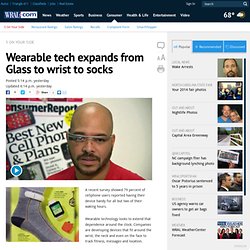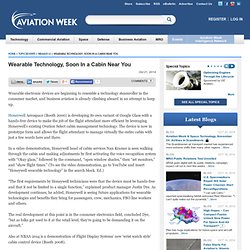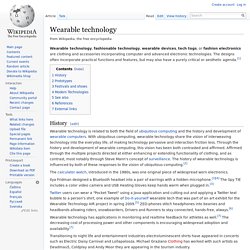

Thanks-to-apple-and-google-wearable-technology-is-on-track-to-become-a-50-billion-market.jpg (JPEG Image, 1000 × 750 pixels) Wearable-technology.jpg (JPEG Image, 468 × 387 pixels) Wearable-technology-on-dezeen.jpg (JPEG Image, 468 × 468 pixels) 140522.pdf. Doc.research-and-analytics.csfb. Wearable-Technology-sep-2013.pdf. Wearable Tech at CES 2014! Future of Glasses, Wearable Technology 2015 - (Future Are Here) Top 5 Wearable Tech! (Early 2014) Wearable tech expands from Glass to wrist to socks. A recent survey showed 79 percent of cellphone users reported having their device handy for all but two of their waking hours.

Wearable technology looks to extend that dependence around the clock. Companies are developing devices that fit around the wrist, the neck and even on the face to track fitness, messages and location. "Wearable tech is still very new, but we really think it's going to take off," said Consumer Reports Carol Mangis. "A lot of big companies are jumping in the game. " Smart watches are one of the fastest growing categories of wearable technology. "It allows me to, at a glance, tell if something is important enough to stop and take care of now or forget until later, or not pay attention to at all," said Pebble watch owner Matt Safford. Consumer Reports has started testing wearable devices that track activity like steps and calories to help users meet their weight goals.
"The first devices we saw were kind of clunky, but that's changing," Mangis said. Experts: Why wearable tech could pose health risks. File photo.

(REUTERS/Adrees Latif) Wearables have arrived. But some doctors and scientists say the latest must-have technology may pose serious health risks to the people wearing them. Internet-connected glasses, smart watches and health monitoring gadgets put wireless technology right on the body, increasing exposure to radio waves among consumers who are already carrying wireless smartphones, tablets and laptops.
Make no mistake … Wearables like Google Glass, Samsung Gear Live and the upcoming Apple Watch are a growing tech category. The good news is that most wearables use Bluetooth technology, which emits much lower levels of radiofrequency, or RF, than cellular-based smartphones and other devices that use Wi-Fi. For example, wearables from Fitbit use Bluetooth Low Energy, which is a “lower power technology than classic Bluetooth typically used in headsets, and operates at powers dramatically lower than cellphones,” a company spokeswoman told Foxnews.com in an email.
Wearable Technology, Soon In a Cabin Near You. Wearable electronic devices are beginning to resemble a technology steamroller in the consumer market, and business aviation is already climbing aboard in an attempt to keep up.

Honeywell Aerospace (Booth 2000) is developing its own variant of Google Glass with a hands-free device to make the job of the flight attendant more efficient by leveraging Honeywell’s existing Ovation Select cabin management technology. The device is now in prototype form and allows the flight attendant to manage virtually the entire cabin with just a few words here and there. In a video demonstration, Honeywell head of cabin services Nan Kramer is seen walking through the cabin and making adjustments by first activating the voice recognition system with “Okay glass,” followed by the command, “open window shades,” then “set monitors,” and “show flight times.” (To see the video demonstration, go to YouTube and insert “Honeywell wearable technology” in the search block.
Ed.) Wearable technology. Wearable technology, fashionable technology, wearable devices, tech togs, or fashion electronics are clothing and accessories incorporating computer and advanced electronic technologies.

The designs often incorporate practical functions and features, but may also have a purely critical or aesthetic agenda.[1] History[edit] Wearable technology is related to both the field of ubiquitous computing and the history and development of wearable computers. With ubiquitous computing, wearable technology share the vision of interweaving technology into the everyday life, of making technology pervasive and interaction friction less. Through the history and development of wearable computing, this vision has been both contrasted and affirmed. The calculator watch, introduced in the 1980s, was one original piece of widespread worn electronics. According to Forbes, 71% of 16-to-24 year olds want wearable tech.[9] Prototypes[edit] Festivals and shows[edit] Modern Technologies[edit] See also[edit]